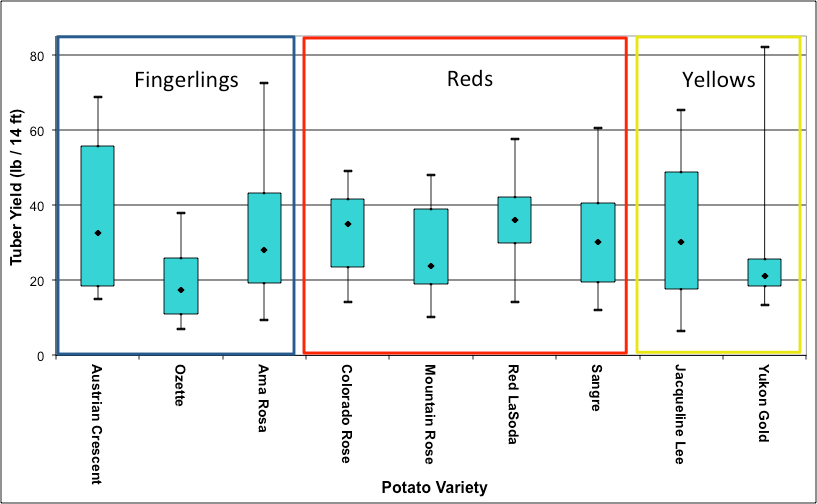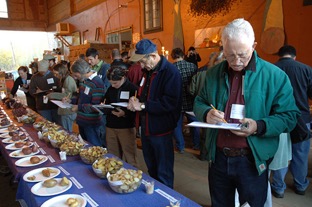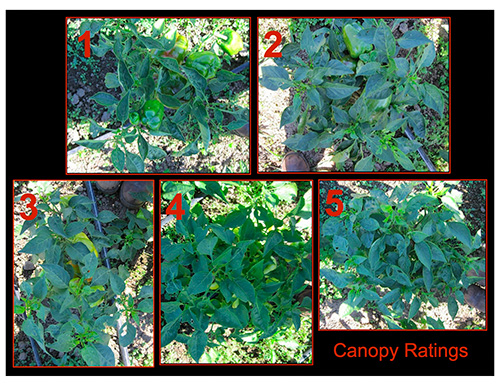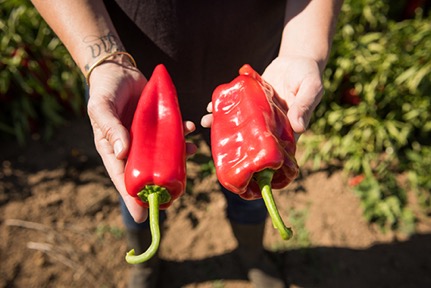eOrganic authors:
Lane Selman, Oregon State University
Alexandra Stone, Oregon State University
James R. Myers, Oregon State University
Introduction
Consumers expect superior flavor, texture, appearance and culinary quality from fresh produce. This is especially true when the produce is organically grown and sold through fresh markets (Bonti-Ankomah and Yiridoe, 2006). University breeders select breeding lines and evaluate commercially available cultivars to identify high performing germplasm. Breeders typically evaluate yield, appearance, pest resistance and sometimes quality variables such as brix and specific gravity. End users are not typically engaged in the evaluation process and quality traits (flavor, texture, culinary attributes) are not evaluated (Sanchez et al., 2012).
Participatory crop improvement projects (PCIPs) are integrated research and extension projects (a form of translational research, according to The Bronfenbrenner Center for Translational Research at Cornell University) that engage end users (e.g. farmers, agricultural professionals, chefs) with serious professional interests in the projected outcomes of the project as full partners/collaborators. All collaborators participate in setting project goals and plans of work, discussing results, and evaluating outcomes. The goal of this approach is to seamlessly integrate research and extension so that research goals are directed by the interests of the end users, and research findings are rapidly implemented. Extension personnel are critical to these projects as they recruit end users with a professional interest in the goals of the project and rapid implementation of its outcomes, coordinate activities that productively and efficiently engage end users, and ensure that the project delivers outcomes with positive, rapid, and meaningful impact.
Qualitative sensory evaluations used by sensory scientists identify consumer preferences. In the most common qualitative approach, consumers are recruited to identify their preference for one of several raw or prepared products. In Robbins (2003), consumers at a farmers market were asked to rank the flavor and texture of specialty potato cultivars in order of preference. In this paper, we describe an alternative approach—participatory culinary quality evaluations—in which end users (farmers, agricultural professionals, and chefs) with serious professional interest in the outcomes of the project evaluate cultivars for culinary quality.
This article describes culinary quality evaluation, yield, and crop quality assessment activities from two PCIPs, with an emphasis on the tasting activities, as they are most novel.
Ospud (2005-2007)
Ospud was a USDA Western SARE-funded project in which Oregon State University and 12 organic farmers focused on improving potato quality and profitability. Project goals included identifying management strategies for tuber flea beetle (Epitrix tuberis) and late blight (Phytophthora infestans), and identifying cultivars with 1) late blight resistance, 2) better yield to replace low-yielding yellow skin/flesh potato ‘Yukon Gold’, 3) novel appearance, and 4) high culinary quality.
Ospud Horticultural Evaluation
Cultivar yield was evaluated in seven on-farm trials in 2007. Nine potato cultivars (Table 1) were planted in March 2007.
Table 1. Potato Cultivars Evaluated in a 2007 Yield Trial on Seven Organic Farms in Western Oregon and Washington
| Cultivar | Type | Reasoning |
| Colorado Rose | Red skin / white flesh | Grown by collaborating farmers |
| Mountain Rose | Red skin / flesh | Grown by collaborating farmers |
| Red LaSoda | Red skin / white flesh | Grown by collaborating farmers |
| Sangre | Red skin / white flesh | Grown by collaborating farmers |
| Jacqueline Lee (Figure 2) | Yellow skin/flesh | Late blight resistant yellow cultivar |
| Yukon Gold (Figure 2) | Yellow skin/flesh | Standard late blight susceptible yellow cultivar |
| Austrian Crescent | Yellow skin/flesh fingerling | Grown by collaborating farmers |
| Ozette | Yellow skin/flesh fingerling | Cultivar with regional cultural importance |
| AmaRosa (Figure 2) | Red skin/flesh fingerling | Breeding line |
Experimental Design: On-farm trials were conducted on seven farms in the Willamette Valley, OR and Skagit Valley, WA. Fourteen seed pieces were planted one foot apart in each of two 15-foot plots on each farm.
Measurements: Marketable potatoes in each plot were weighed at harvest. Tubers were considered unmarketable if they were not of standard size.
Statistical Analysis: The between-row spacing was different on the seven farms, so yields could not be compared on a per-acre basis. Instead, yields on each farm were analyzed using a box plot, which displays the median and range in plot yields on each farm.
Ospud Yield Evaluation Results
Overall, in trials on seven farms, 'AmaRosa' yielded comparably to the other red and fingerling varieties, and 'Jacqueline Lee' yielded comparably to 'Yukon Gold' (Fig. 1).

Figure 1. Box-plot representation of the yields of nine potato cultivars grown on seven organic farms in Oregon and Washington in 2007. (The dot represents the median yield across all farms. Fifty percent of the yields fall within the box. The "whiskers" represent the full range in yield.)
Ospud Culinary Quality Evaluation
Germplasm: A culinary quality evaluation was conducted of six commercially-available potato cultivars and eleven breeding lines (Table 2). Breeding lines came from the Oregon State University (OSU) potato breeding program.
Table 2. Potato Cultivars and Breeding Lines Evaluated in a 2006 Potato Culinary Quality Evaluation at Gathering Together Farm in Philomath, Oregon.
| Cultivar | Type | Reasoning |
| All Blue | Purple skin/flesh | Grown by collaborating farmers |
| All Red | Red skin/flesh | Grown by collaborating farmers |
| Jacqueline Lee | Yellow skin/flesh | Grown by collaborating farmers |
| Red Gold | Red skin/Yellow flesh | Grown by collaborating farmers |
| Russian Banana | Yellow skin/flesh fingerling | Grown by collaborating farmers |
| Yukon Gold | Yellow skin/flesh | Standard yellow cultivar (typically low yielding) |
| AC97521-1R/Y | Red skin/Yellow flesh | Breeding line |
| CO97226-2R/R | Red skin/flesh | Breeding line |
| CO97232-1R/Y | Red skin/Yellow flesh | Breeding line |
| CO97233-3R/Y | Red skin/Yellow flesh | Breeding line |
| OR00068-11 | Purple skin/flesh | Breeding line |
| OR00068-29 | Purple skin/flesh | Breeding line |
| POR00PG4-1 | Red skin/Yellow flesh | Breeding line |
| POR01PG16-1 | Purple skin/flesh | Breeding line |
| POR01PG22-1 | Red skin/flesh fingerling | Breeding line, later released as 'AmaRosa' |
| POR01PG45-5 | Purple skin/Yellow flesh | Breeding line |
| POR03PG80-2 | Purple skin/Yellow flesh | Breeding line |
Venue/Chef: The evaluation was conducted at the Gathering Together Farm restaurant in Philomath, OR. Samples were prepared by Chef Laurie Kennedy.
Sample Preparation: A representative tuber for each variety was displayed as raw (whole and halved) and steamed on a plain white plate and labeled with a random, numeric code (Fig. 2). Potatoes were sliced evenly into 1/8” pieces and steamed over boiling water for 10 minutes. One-half teaspoon of salt was added per cup of potatoes.

Figure 2. Tubers of 'Jacqueline Lee', 'Yukon Gold', and 'AmaRosa' (identified as POR01PG22-1 at the time of the project). Photo credit: Lane Selman, Oregon State University.
Evaluators: Forty-five farmers, potato breeders, potato seed producers, produce buyers, potato processors, researchers, and extension faculty evaluated potatoes (Fig. 3).
Evaluation Protocol: Individuals evaluated flavor, texture, and overall liking for steamed preparations of each entry. Evaluators used a 1—9 hedonic scale (1 = dislike extremely; 9 = like extremely). A comment box was included for additional remarks.

Figure 3. Farmers, breeders, chefs, and agricultural professionals evaluating culinary qualities of potato cultivars at Gathering Together Farm in Philomath, Oregon, 2006. Photo credit: Lynn Ketchum, Oregon State University.
Statistical Analysis: Analysis of variance was performed using the statistical software StatPlus. Fischer's protected least significant difference (LSD) at α = 0.05 was used for mean separation.
Ospud Culinary Quality Evaluation Results
Table 3. Mean Ratings for Steamed Potatoes in a 2006 Culinary Quality Evaluation at Gathering Together Farm in Philomath, Oregon. (Means followed by the same letter within a column are not significantly different at P ≤ 0.05.)
| Variety | Flavor | Texture | Overall Liking |
| Yukon Gold | 6.8 a | 6.6 a | 6.2 a |
| Jacqueline Lee | 6.7 a | 7.0 a | 6.7 a |
| Russian Banana | 6.1 ab | 6.4 ab | 5.9 ab |
| AmaRosa | 6.0 ab | 6.1 ab | 5.8 ab |
| POR01PG16-1 | 5.6 ab | 6.0 ab | 5.7 ab |
| CO97232-1R/Y | 5.5 ab | 6.2 ab | 5.5 ab |
| All Blue | 5.5 ab | 5.4 ab | 4.6 b |
| AC97521-1R/Y | 5.3 ab | 6.5 ab | 6.0 a |
| Red Gold | 5.3 ab | 5.3 b | 5.3 ab |
| All Red | 5.2 ab | 4.7 b | 4.9 ab |
| POR01PG45-5 | 5.2 ab | 5.0 b | 4.6 b |
| CO97233-3R/Y | 5.2 ab | 5.5 ab | 5.2 ab |
| POR00PG4-1 | 5.0 b | 5.2 b | 5.4 ab |
| POR03PG80-2 | 4.9 b | 4.7 b | 4.5 b |
| OR00068-29 | 4.7 b | 4.5 b | 4.5 b |
| OR00068-11 | 4.6 b | 4.9 b | 4.0 b |
| CO97226-2R/R | 4.2 b | 6.2 ab | 4.5 b |
Evaluators rated 10–12 cultivars, including 'Jacqueline Lee', 'Yukon Gold' and 'AmaRosa', highly for flavor, texture and overall liking (Table 4). There was no significant difference amongst 'AmaRosa', 'Yukon Gold' and 'Jacqueline Lee' in any of the three factors. 'Yukon Gold' and 'Jacqueline Lee' were consistently ranked numerically first and second in flavor, texture, and overall liking. 'AmaRosa' was consistently ranked in the top seven. While there was not a statistically significant difference in any of the three culinary quality variables amongst 'AmaRosa' and the other two red potatoes ('All Red' and 'Red Gold'), 'AmaRosa' consistently ranked numerically higher than the other two red potatoes. Evaluators rated the textures of 'Red Gold' and 'All Red' as significantly poorer than the textures of 'Yukon Gold' and 'Jacqueline Lee', but not different from the texture of 'AmaRosa'.
Ospud Discussion
The goals described by the project's collaborating farmers were met. 'Jacqueline Lee', a waxy yellow potato with documented resistance to foliar late blight, was shown to have similar culinary quality to the standard late blight-susceptible yellow variety 'Yukon Gold', while yielding comparably on collaborating farms.
'AmaRosa', a novel red flesh/red skin fingerling potato (evaluated as the numbered breeding line POR01PG22-1 during the project) was rated highly for flavor, texture and overall liking; it yielded comparably to other fingerlings and red potatoes when grown on collaborating farms. The Oregon State University Potato Program released 'AmaRosa' in 2010. Many growers and marketers (e.g. Klamath Basin Fresh Organics, Frieda's) are now growing and/or marketing these potatoes by name and they are available as seed from at least three sources.
NOVIC (2010-2018)
The Northern Organic Vegetable Improvement Collaborative (NOVIC) is a USDA-NIFA-OREI-funded collaborative project (Oregon State University, University of Wisconsin, Cornell University, Organic Seed Alliance, USDA-Agricultural Research Service, and approximately 100 organic farmers). NOVIC's goal is to improve cultivars of six vegetable crops for organic production. This paper describes efforts in Oregon to identify an open-pollinated, early-maturing, high-yielding sweet red pepper of high culinary quality to substitute for ‘Gypsy’, a dependable red F1 hybrid for which it was increasingly difficult to source seed.
NOVIC Horticultural Evaluation
Nine cultivars (Table 4) were seeded in the third week of March and transplanted in the field in the third week in May, 2011.
Table 4. Pepper Cultivars in 2011 Horticultural and Culinary Quality Evaluations
| Variety | Seed Source | Rationale |
| Gypsy | Territorial Seeds | Standard variety, performs well on organic farms |
| Gatherer's Gold | Wild Garden Seed | Locally-bred variety |
| Joelene's Rustic Italian | Wild Garden Seed | Locally-bred variety |
| Little Bells | Wild Garden Seed | Locally-bred variety |
| Stocky Red Roaster | Wild Garden Seed | Locally-bred variety |
| King Crimson | High Mowing Seeds | Virus resistant, bred by Cornell University |
| Shepherd's Ramshorn | Adaptive Seeds | Locally-offered variety |
| Symmetry | Foundhorn Garden | Locally-bred variety |
| Reliably Red | Foundhorn Garden | Locally-bred variety |
Experimental Design: A mother-daughter (or mother-baby) trial design was used (Snapp, 2002). In this trialling strategy, a replicated (at least three plots of each variety) mother trial is planted on the research station and daughter trials consisting of one or two plots of each variety are planted on several commercial farms in the region. The mother trial for peppers was located at the Oregon State University Lewis Brown Horticultural Research Farm in Corvallis, Oregon. A randomized complete block design with three plots per variety was used. Plots were ten feet long with two rows of six plants spaced eighteen inches apart for a total of twelve plants in each plot. The three daughter farms (located near Philomath, Portland, and Sauvie Island, Oregon) each planted one plot of twelve plants per variety.
Measurements: All plots were evaluated for total and marketable yield and plant canopy. Plant canopy was rated using a 1–5 scale (Fig. 4) developed to rate the percentage of leaf cover over fruits, where 1 is minimal cover and 5 is complete coverage of fruit by the foliage. Fruits were considered unmarketable if they were cracked, sunburned, or not of standard size. Harvest was conducted weekly until frost at the end of October, at which point all fruit was harvested, including remaining green fruit.

Figure 4. Plant canopy cover rating scale for the 2011 NOVIC pepper trial. Photo credit: Lane Selman, Oregon State University.
NOVIC Horticultural Evaluation Results
Table 5. Mean Fruit Yield and Size and Plant Canopy Cover for Sweet Peppers at Three Organic Farms in Western Oregon in 2011.
| Variety | Marketable fruit wt. (T A-1) | Total fruit wt. (T A-1) | Fruit size (oz) | Canopy cover* |
| Stocky Red Roaster | 24.9 a | 26.6 a | 2.0 a | 3.9 a |
| Gatherer's Gold | 19.5 ab | 21.8 ab | 2.9 b | 2.5 de |
| Gypsy | 18.8 ab | 21.0 ab | 3.5 b | 2.3 e |
| Little Bells | 18.2 b | 20.8 ab | 3.5 b | 3.1 bc |
| King Crimson | 17.7 b | 23.6 ab | 4.9 c | 3.5 ab |
| Shepherd's Ramshorn | 16.6 bc | 21.1 ab | 4.3 c | 3.1 bcd |
| Joelene's Rustic | 15.2 bc | 19.9 ab | 3.3 b | 3.2 bc |
| Reliably Red | 10.6 cd | 17.4 b | 6.2 d | 3.0 bcd |
| Symmetry | 6.6 d | 16.2 b | 7.7 e | 2.7 cde |
'Stocky Red Roaster' (SRR) had the largest and most upright canopy (Table 5). Total yield for 'Stocky Red Roaster was not statistically different from 'Gatherer's Gold' and 'Gypsy' (Table 5). However, SRR generated very few unmarketable fruit, so its marketable yield was 30% higher than 'Gatherer's Gold' and 35% higher than 'Gypsy', the standard red variety. SRR had the smallest fruit of the cultivars grown in this trial (Table 5). SRR generated few culls due to its large canopy and small fruit size, both of which reduced sunscald, the primary reason for culling.
NOVIC Culinary Quality Evaluation
Germplasm: The same nine bell and Italian roasting cultivars that were evaluated in the horticultural trial were evaluated in the culinary quality trial (Table 4 above). Cultivars were selected because they had performed well when grown by collaborating farmers or because they appeared in seed catalogs to have similar culinary qualities to ‘Gypsy’.
Venue/Chef: The culinary quality evaluation was performed at Table Mediterranean Bistro in Portland, Oregon. Samples were prepared by Chef Anthony Cafiero.
Sample Preparation: Raw samples were cut evenly into 1/8” strips. Sautéed samples were cut in the same manner then sautéed in a stainless steel pan over medium-high heat with a blended oil (70% canola/30% olive) for 5 minutes and sprinkled with sea salt after removal from heat. One tablespoon oil and ½ teaspoon salt was added to every cup of peppers. Roasted peppers were roasted whole at 215°F for 30 minutes, then peeled, seeded and cut into ½” pieces. A representative fruit for each cultivar was displayed raw (whole and halved). Pepper samples for tasting were displayed on plain white dinner plates and labeled with a random, numeric code (Fig. 5).

Figure 5. Culinary quality evaluation display for sweet peppers in Portland, Oregon. In the trial, the reverse side of the label was displayed with a numerical code rather than the variety name. Photo credit: Lane Selman, Oregon State University.
Evaluators: Twenty-three plant breeders, seed producers, farmers, and chefs who frequently bought produce from local farmers’ markets participated in the culinary quality evaluation.
Evaluation Process: Individuals evaluated each cultivar for overall liking and appearance as well as its flavor when prepared raw, sautéed, and roasted. Evaluators used a 1—9 hedonic scale (1 = dislike extremely; 9 = like extremely). A comment box was included for additional remarks.
Statistical Analysis for Horticultural and Culinary Quality Evaluations: Data were analyzed in SAS 9.2 using PROC GLM (variety, farm, and variety x farm interaction, replications omitted). Fischer's protected least significant difference (LSD) at α = 0.05 was used for mean separation.
NOVIC Culinary Quality Evaluation Results
Table 6. Mean Ratings for Preference, Appearance, and Flavor of Sweet Peppers Grown in a Mother-Daughter Trial with Four Locations in Western Oregon in 2011.
| Variety | Overall Liking | Appearance | Flavor (raw) | Flavor (sautéed) | Flavor (roasted) |
| Joelene's Rustic | 7.9 a | 8.3 a | 7.0 a | 7.1 ab | 6.4 ab |
| Gatherer’s Gold | 7.6 ab | 7.9 abc | 6.7 ab | 7.7 a | 6.3 ab |
| Stocky Red Roaster | 7.6 abc | 8.1 ab | 6.6 ab | 7.4 ab | 6.6 a |
| Shepherd’s Ramshorn | 6.6 bcd | 7.3 abcd | 5.9 ab | 6.4 ab | 6.5 ab |
| Little Bells | 6.4 d | 6.3 e | 6.4 ab | 6.5 ab | 6.2 ab |
| King Crimson | 5.7 d | 4.6 f | 5.4 b | 5.2 c | 5.2 b |
| Gypsy | 4.4 e | 6.9 de | 6.3 ab | 6.7 ab | 6.5 ab |
| Reliably Red | 3.9 ef | 5.0 f | 2.9 c | 3.3 d | 3.1 c |
| Symmetry | 2.9 f | 5.1 f | 2.6 c | 3.4 d | 2.9 c |

Figure 6. Evaluators of the 2011 NOVIC pepper trials preferred the appearance of fruits with rounded shoulders like those of 'Stocky Red Roaster' (L) compared to 'Joelene's Rustic' (R). Photo credit: Shawn Linehan, Shawn Linehan Photography.
Overall, evaluators liked 'Joelene's Rustic', 'Gatherer's Gold', 'Shepherd's Ramshorn', 'Stocky Red Roaster', 'Little Bells' and 'King Crimson' more than 'Gypsy' (Table 6). 'Joelene's Rustic', 'Gatherer's Gold' and 'Stocky Red Roaster' were rated as having better appearance than 'Gypsy' (Table 6). 'King Crimson', 'Symmetry' and 'Reliably Red' were rated as having poorer flavor than 'Gypsy' when sautéed or roasted, but no varieties had significantly better flavor than 'Gypsy,' regardless of the cooking method (Table 6). Comments on evaluation ballots indicated that evaluators preferred the appearance of 'Stocky Red Roaster' with its rounded shoulders for easier processing in the kitchen (Fig. 6).
NOVIC Discussion
Collaborating farmers initiated the pepper project to find a sweet red open-pollinated roasting pepper to replace ‘Gypsy’ F1, as its seed had become increasingly difficult to source. The ‘Stocky Red Roaster’ pepper bred by collaborating breeder Frank Morton of Wild Garden Seed was identified as filling this niche. 'Stocky Red Roaster' was shown to be similar in yield to 'Gypsy' and significantly higher yielding than most other trial peppers. In addition, it was ‘liked’ and had a better appearance than 'Gypsy', and its flavor raw, sautéed and roasted was comparable to 'Gypsy'. Because of 'Stocky Red Roaster'’s high horticultural and culinary quality, collaborating farmers adopted 'Stocky Red Roaster' as a replacement for 'Gypsy.' In addition, it is now offered by more than ten seed companies and seed sales have increased by more than five hundred percent (personal communication, Frank Morton).
Conclusion
Two participatory crop-improvement projects (Ospud and NOVIC) sought to integrate culinary quality evaluation into their assessments of vegetable cultivars, as the customers of the projects’ collaborating farmers demanded high culinary quality. In both projects, culinary quality evaluations successfully differentiated varieties of high and low quality. This information, along with production data, including yield and disease resistance, identified cultivars and breeding lines of high market value that were also likely to perform well in the field. Because extension personnel successfully implemented the participatory research and extension (translational research) model, in which end users with strong professional interests in the outcomes of the project were integrated into project activities from goal-setting to evaluation, the results of these projects were immediately implemented by the end users and the projects resulted in strong and rapid impact.
References and Citations
- Bonti-Ankomah, S., and E. K. Yiridoe. 2006. Organic and conventional food: A literature review of the economics of consumer perceptions and preferences. Final report. (Available online at: https://www.researchgate.net/publication/229051543_Organic_and_conventional_food_a_literature_review_of_the_economics_of_consumer_perceptions_and_preferences) (verified 27 Aug 2017).
- Cornell University. The Bronfenbrenner Center for Translational Research [Online]. Available at a href="https://www.bctr.cornell.edu">https://www.bctr.cornell.edu) (verified 27 Dec 2017).
- Douches, D. S., K. Jastrzebski, J. Coombs, W. W. Kirk, K. J. Felcher, R. Hammerschmidt, and R. W. Chase. 2001. Jacqueline Lee: A late-blight-resistant tablestock variety. Journal of Potato Research 78:413–419. (Available online at: https://msu.edu/~douchesd/papers/Jacqueline%20Lee%20AJPR%202001.pdf) (verified 27 Aug 2017).
- Montri, D. N., K. M. Kelley, and E. S. Sanchez. 2006. Direct marketing edamame (Glycine max [L.] Merrill) to professional chefs [Online]. Journal of Extension 44(1) Article 1RIB4. Available at http://www.joe.org/joe/2006february/rb4.php (verified 23 Aug 2017).
- Potato Variety Management Institute. 2010. AmaRosa potato [Online]. Available at: http://www.pvmi.org/varieties/Type/AmaRosa.htm (verified 27 Aug 2017).
- Robbins, J. 2003. A simple method to determine consumer preference [Online]. Journal of Extension 41(5) Article 5TOT4. Available at: http://www.joe.org/joe/2003october/tt4.php (verified 23 Aug 2017).
- Sanchez, E. S., T. M. Butzler, L. J. Stivers, T. E. Elkner, S. M. Bogash, R. E. Oesterling, and M. D. Orzolek. 2012. Pennsylvania statewide winter squash cultivar evaluation. HortTechnology 22(8), 826–837. (Available online at: https://journals.ashs.org/horttech/view/journals/horttech/22/6/article-p826.xml) (verified 2 Dec 2019).
- Snapp, S. 2002. Quantifying farmer evaluation of technologies: The mother and baby trial design. In Bellon, M. R. and J. Reeves (eds). Quantitative analysis of data from participatory methods in plant breeding. Mexico, DF: CIMMYT. (Available online at: https://www.researchgate.net/publication/237062899_Quantitative_Analysis_of_Data_from_Participatory_Methods_in_Plant_Breeding) (verified 27 Aug 2017).
- Wild Garden Seed (n.d.). Stocky Red Roaster [Online]. Available at: https://www.wildgardenseed.com/product_info.php?products_id=231) (verified 27 Aug 2017).



